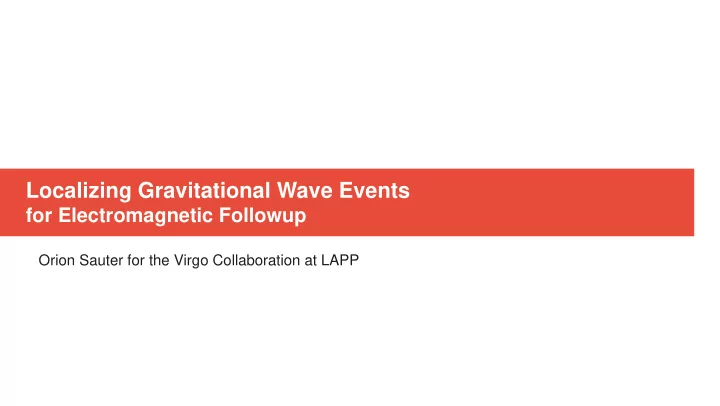

Localizing Gravitational Wave Events for Electromagnetic Followup Orion Sauter for the Virgo Collaboration at LAPP
Effect of Gravitational Waves Alternately stretch and squeeze space Change proportional distance between points Extremely weak: O(10 -22 ) or less Created by accelerating masses, e.g. compact binaries, spinning neutron stars Wikipedia 9 July 2019
Gravitational Wave Detectors Cyril FRESILLON/Virgo/CNRS PHOTOTHEQUE Virgo Collaboration 9 July 2019
Gravitational Wave Detectors Fabry-Perot interferometer Heavy mirrors with pendulum suspension for seismic isolation Intensity of light at output depends on difference in arm length Gravitational wave changes differential arm length, resulting in interference J. Aasi et al. 2015 9 July 2019
Detector Network The Virgo Collaboration/LAPP and Tom Patterson 9 July 2019
Sky-Localization Arrival times at each detector compared Phase-shift required to bring signals into alignment informs direction Detection template includes masses/spins ‒ Distance based on expected magnitude 9 July 2019
Search Templates Calculate expected gravitational waveforms, then search for correlation with detector output When looking for detector coincidence, must use same template across detectors Choose density of templates for some maximum mismatch 9 July 2019
Antenna Pattern M. Rakhmanov et al. 2008 9 July 2019
Antenna Pattern B. Abbott, 2019 9 July 2019
First BNS: GW170817 Despite being online, Virgo did not detect Suggested source was in a blind-spot Using antenna pattern, able to narrow region enough to allow fast EM detection 9 July 2019
Recent Public Alert: S190701ah 9 July 2019
Alerts For events with sufficiently low false-alarm rate, TITLE: GCN CIRCULAR NUMBER: 21505 SUBJECT: LIGO/Virgo G298048: Fermi GBM trigger 524666471/170817529: GCN notice is sent LIGO/Virgo Identification of a possible gravitational-wave counterpart DATE: 17/08/17 13:21:42 GMT FROM: Reed Clasey Essick at MIT <ressick@mit.edu> The LIGO Scientific Collaboration and the Virgo Collaboration report: Includes localization skymap The online CBC pipeline (gstlal) has made a preliminary identification of a GW candidate associated with the time of Fermi GBM trigger 524666471/170817529 at gps time 1187008884.47 (Thu Aug 17 12:41:06 GMT 2017) with RA=186.62deg Dec=-48.84deg and an error radius of 17.45deg. P astro : Probability that trigger is astrophysical (not The candidate is consistent with a neutron star binary coalescence with False Alarm Rate of ~1/10,000 years. terrestrial) An offline analysis is ongoing. Any significant updates will be provided by a new Circular. [GCN OPS NOTE(17aug17): Per author's request, the LIGO/VIRGO ID was added to the beginning of the Subject-line.] EMBright: Probability that event is visible in EM spectrum (NS component) 9 July 2019
Continuous Waves Also expect to find waves from isolated spinning neutron stars Signals are much weaker, but last many years Can sum signal coherently to detect through noise Targeted searches for known pulsars (e.g. Scorpius X1) NASA/Goddard/CI Lab 9 July 2019
“Pointing” the Detector For long-lasting signals, localization is possible even with a single detector At different points in Earth’s orbit, signal travel time will be different GR effects if signal passes through massive objects (Sun, Jupiter) Want to convert between detector reference frame and source frame Precision provided by TEMPO2 radio astronomy package is 1 ns ~ 30 cm 9 July 2019
Earth Position in ICRF Own Work 9 July 2019
Doppler Shift Own Work 9 July 2019
Multi-Messenger Astronomy With a growing network of interferometers, localization will improve By collaborating with EM partners, we can pool our findings to learn more about the universe Many opportunities to confirm or rewrite physical laws (speed of gravity, black hole/neutron star populations, etc.) 9 July 2019
Recommend
More recommend